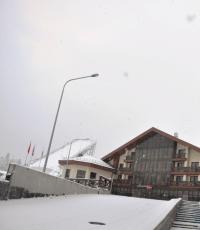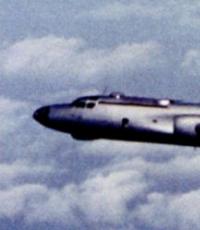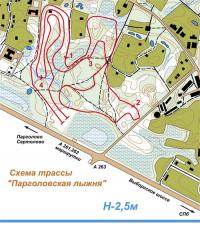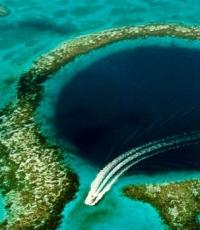Airbus A320 family crashes. Chronology. Lost flight: what is known about the causes of the A321 crash a year later The plane was shot down
Until now, the picture of the crash looked too contradictory, which gave rise to a lot of rumors and unconfirmed versions that instantly spread in the media. Officially, at the moment, only the fact that the plane began to fall apart in the air has been confirmed. This was announced by the head of the Federal Air Transport Agency Alexander Neradko. According to him, the wreckage of the aircraft scattered within a radius of 20 km.
All other data about the catastrophe that appeared earlier are now almost completely refuted. The statistics of such refutations of MK was presented by specialists of the International Consultative and Analytical Agency Flight Safety:
The information that the crew reported a problem on board, that they requested a landing in Cairo or at another nearby airfield was refuted by the Minister civil aviation Egypt, which on the evening of November 1 said that the Russian crew did not give distress signals and did not get in touch.
The information that the plane crashed, and two of its large parts - the fuselage and tail - are on the ground, was refuted by the video.
The information that the tail section was burned is also refuted by photographs and video.
Information that rescuers hear the groans of passengers inside crashed plane, refuted appearance debris - no one can survive with such destruction.
In the meantime, Sergey Melnichenko, director general of the International Advisory and Analytical Agency Flight Safety, told MK that Egypt has published information that contains a proposal to airlines not to use the airspace over North Sinai until the circumstances of the incident are clarified. So the wave of messages from carriers about the suspension of flights in this area is no longer their own initiative, announced earlier, allegedly in order to reassure passengers.
According to Melnichenko, satellite photographs that have become available on the Internet, showing areas of debris fall, indicate that the dispersion of parts of the aircraft over an area of several kilometers really gives reason to believe that the disintegration of the A321 began in the air. It is possible that the front part of the aircraft, where the transponder and its antenna are located, flew a slightly greater distance than the first structural parts that separated from the aircraft - they were found along the route closer than the point where the mark from the transponder disappeared.
“The fact that the front of the aircraft lies in an inverted position,” says Sergey Melnichenko, “is explained by the laws of aerodynamics and the design of the aircraft. While the wings provide lift, the stabilizer located on the tail is responsible for the longitudinal stability of the aircraft. If we assume that the tail part for some reason separated in the air, then the nose of the aircraft will immediately go down, and the part remaining behind the wings up. So it remains to establish the cause of the separation of the tail section, and the main and concomitant causes of the accident will become clear. Hopefully, they will actually be found."
In this regard, the main hopes of all experts to establish the true causes of the disaster are now connected with the decoding of the "black boxes". However, specialists from the Flight Safety Agency believe that “it is possible that the data obtained after decoding the recorders will not be enough to fully restore the picture of what happened. Recall how many hopes were associated with the decoding of the "black boxes" of the downed Malaysian Boeing, but it only confirmed that the plane fell as a result of external influences.
On the morning of October 31, a plane crash occurred on the territory of the Sinai Peninsula, killing 224 people. 30 minutes after takeoff, the Airbus A321 airliner of the Kogalymavia company, flying from Sharm el-Sheikh to St. Petersburg, disappeared from the radar. The plane began to rapidly lose altitude and, according to preliminary information, fell apart before falling.
The plane crash in the Sinai became the largest in terms of the number of victims in the history of Russian and Soviet aviation. Prior to this, the sad list was headed by the tragedy that occurred near Uchkuduk on July 10, 1985. Then the Tu-154 crash claimed the lives of 200 people.
What happened on Saturday in the Sinai Peninsula? While experts are dealing with the contents of the "black boxes" of the crashed liner, the first versions of what happened are already appearing.
Photo gallery


















The Indian military destroyed a space satellite in low Earth orbit during a missile test, Prime Minister Narendra Modi announced in an address to the nation.1 of 18
Engine failure
The most popular version is the failure of the aircraft engines. According to some reports, a few minutes before the crash, the pilots contacted the dispatchers and requested permission for an emergency landing due to the failure of one of the engines, according to others, there was nothing of the kind. Egyptian officials adhere to the second option: no one contacted the ground, the flight took place as normal.
The Egyptian press cites the words of one of local residents, who allegedly saw one of the turbines ignite in the air near the liner.
However, this version also has weaknesses. For the plane to crash, several engines had to fail at once. In other words, the failure of one engine could not lead to a plane crash.

Damage to an aircraft on another flight
The second version is that the plane was damaged in some other flight and they were simply not noticed in time. And if they noticed, then the plane was "patched" poorly. The crashed airliner was 18 years old, during such a period of operation during flights, emergency situations occurred more than once. So, 14 years ago, when landing in Cairo, the plane hit hard with its tail, after which it was under repair for a long time.
Air crashes that occurred due to poor-quality repairs or negligent inspection of aircraft are not the greatest rarity. So, on August 12, 1985, a Boeing 747 crash near Tokyo claimed the lives of 520 people. It turned out that the cause of the tragedy was a poorly carried out repair: the workers poorly welded the pressure bulkhead, which fell off during the flight along with the elevators.
The plane became practically uncontrollable, the pilots kept the liner in the air for another half an hour, managing to control the liner by reducing and increasing the engine thrust. However, the plane then crashed into a mountain.
According to an Egyptian technician who inspected the Airbus A321 before takeoff, it was in perfect working order.
The plane was shot down
The last of the most popular versions. The plane could have been shot down by militants of the Islamic State terrorist group banned in Russia. Currently, a bloody war is going on in the Sinai Peninsula between the troops of the Egyptian government and the Islamic State.
It is possible that the militants fired a rocket that shot down the plane. However, this version is opposed by the lack of appropriate funds from IS, because the liners fly at an altitude of about 9-10 thousand meters. It is possible to shoot down a liner only with the help of a missile system.
However, on the eve there was information that the plane did not have time to gain altitude, which means that it completely became a target for MANPADS. ISIS has already published a video showing a plane being shot down by a missile, but there are serious doubts about the authenticity of the recording.
Some conclusions can be drawn after the official investigation of the IAC and the decoding of the "black boxes". As part of the investigation into the crash of the Airbus A321, investigators seized documents on the maintenance of the vessel. In Samara, fuel samples were seized from the place of the last refueling of the aircraft, said the official representative of the TFR, Vladimir Markin.
"The Russian Investigative Committee will check all possible versions that could lead to the tragedy, including the technical malfunction of the aircraft," Markin said.
On October 31, 2015, a Russian Airbus A321 of Kogalymavia (Metrojet) operating flight 9268 from Sharm el-Sheikh to St. Petersburg, on the Sinai Peninsula in Egypt.
There were 224 people on board the aircraft, including 217 passengers (58 men, 134 women and 25 children - of which 212 people were citizens Russian Federation, four people are citizens of Ukraine, one citizen of Belarus) and seven crew members.
The plane flew mostly residents of St. Petersburg. Residents of neighboring regions also returned to Russia - the Leningrad Region, Novgorod, Pskov, Karelia, several people from other subjects of the Federation. All on board were killed. The disaster was the largest in the history of Russian and Soviet aviation.
The Airbus-A321 aircraft of the Kogalymavia airline (Metrojet), in which the Brisco tour operator, flew from Sharm el-Sheikh (Egypt) to St. Petersburg on October 31 at 06.51 Moscow time and disappeared from the radar screens after 23 minutes. According to the Egyptian Civil Aviation Authority, the liner followed at an altitude of 9.4 kilometers, then dropped sharply by 1.5 kilometers, after which it disappeared from radar.
The fate of the aircraft was not reported long enough. The liner disappeared from radar screens in the Cyprus region, so for half an hour they could not determine the exact location of a possible crash.
For searches Russian aircraft was the military aviation of Egypt. Israel Defense Forces services of Egypt, sending its reconnaissance aircraft to participate in the search operation.
The wreckage of A321 was found in the center of the Sinai Peninsula in the mountains between the areas of El-Kantala and El-Laksim near the city of Al-Hasna. To identify the aircraft, Egyptian emergency services were sent to the place of detection, where a large-scale search and rescue operation was carried out.
In agreement with Cairo, a grouping of forces and means of the Russian Unified State System for the Prevention and Elimination of Emergencies (RSChS) in the amount of more than one thousand people and 250 pieces of equipment was involved in the elimination of the consequences of the crash of the liner, of which more than 660 people and 100 units were from the Russian Emergencies Ministry technicians, as well as psychologists EMERCOM of Russia.
Search operations were organized on the spot using unmanned aerial vehicles and space monitoring data, more than 40 square kilometers of the territory were examined.
On the day of the crash, two A321 airborne emergency recorders were also found in Cairo - speech and parametric.
In connection with the crash of a Russian plane in Egypt, Russian President Vladimir Putin declared mourning in the country on November 1, 2015. The authorities of St. Petersburg until November 3, and the Leningrad region - until November 4.
The Investigative Committee of the Russian Federation on the fact of the crash of a Russian aircraft in Egypt was first under the article "Violation of flight rules and preparation for them", then another one under the article "Performance of work or provision of services that do not meet safety requirements." Later they were in the same production.
On behalf of the President, the Russian government in connection with the disaster, headed by the Minister of Transport Maxim Sokolov. The Interstate Aviation Committee (IAC) was under the leadership of the executive director of the committee, Viktor Sorochenko.
Cairo immediately after the disaster, all interested countries about the opportunity to participate in the investigation of the tragedy. A special one was created, it included specialists from five countries: Russia, Egypt, France (the state of the aircraft developer), Germany (the state of the liner manufacturer) and Ireland (the state of registration). Ayman al-Muqaddam was appointed head of the commission to investigate the disaster.
November 1, 2015 Egyptian Attorney General Nabil Ahmed Sadeq in an investigation into the causes of the crash with a Russian plane in the Sinai Peninsula. According to the Russian Ambassador to Cairo, Sergei Kirpichenko, Russia and Egypt have, according to which Russian specialists have access to almost everywhere they want to go as part of the investigation of the A321 crash.
A group of investigators and forensic experts from the central office of the Investigative Committee of Russia, in agreement with the competent authorities and together with representatives of the Republic of Egypt, in accordance with the norms of national and international law, participated in the inspection of the crash site in Egypt.
The head of the FSB of the Russian Federation, Alexander Bortnikov, during a meeting in the Kremlin on the results of the investigation into the causes of the crash of the Russian plane, said that as a result of the study of personal belongings, luggage and parts of the plane that crashed in Egypt, traces of a foreign-made explosive were found. It happened like a terrorist attack.
In turn, the Egyptian authorities. Egyptian Foreign Minister Sameh Shukri said that this criminal case considers the attack as one of the versions.
In March 2016, the International Commission to Investigate the Crash of the Russian Aircraft A321 announced that it was from the Russian Investigative Committee and handed it over to the Egyptian Prosecutor General's Office to complete legal procedures. The commission itself, despite the transfer of the case to the investigating authorities of the state security of the country, will continue the technical examination of the wreckage of the liner.
In mid-April, Egypt's Attorney General Nabil Sadeq reported on the crash of a Russian plane to the country's Supreme State Security Prosecutor's Office. The decision of the head of the supervisory agency, noted in the text of the statement, was made on the basis of data from the report of the Investigative Committee of Russia, "which indicates the suspicion of a criminal trace."
In June, CIA Director John Brennan, speaking in the US Senate, said that American intelligence about the involvement in the explosion on the Russian passenger plane A321 of the Egyptian group Ansar Beit al-Maqdis, who swore allegiance to the terrorist movement "Islamic State" banned in many countries (ISIS), and on August 4, the Egyptian Ministry of Defense announced the liquidation of the leader of this terrorist group.
On August 28, the commission for the investigation of the crash began "laying out" fragments of the aircraft structure in an aviation hangar in the city of Cairo, where they were delivered from the crash site. after its completion, the point was determined from which the destruction of the hull of the liner began.
According to media reports, when analyzing the calculations of the assembled fragments of the A321 in the hangar of the Cairo airport, experts that the terrorists placed an explosive device in the tail of the vessel, the explosion caused the separation of the tail section and an uncontrolled dive. According to them, Russia has almost completed a report on the causes of the disaster, clearly pointing to a terrorist trail: a powerful explosive device with a clockwork was used, which provoked a strong blast wave and fire.
Investigation into the crash of the Russian A321 over the Sinai Peninsula. On October 24, it became known that a commission of inquiry formed by the Egyptian Attorney General's Office sent twelve of the wreckage of the liner to an alloy science laboratory for a detailed study.
After the disaster, flights to Egypt from the Russian Federation and the tourist flow were. Russia announced the need to ensure security at Egyptian airports in order to resume air traffic between the countries. Flights to this country have also been suspended by a number of European airlines. The Egyptian authorities are making great efforts to improve security measures in resort areas and airports, wanting to restore the tourist flow. In the months that have passed since the tragedy, many foreign expert delegations have visited Cairo, Hurghada and Sharm el-Sheikh with the security inspection of Egyptian airports.
The material was prepared on the basis of information from RIA Novosti and open sources
An American infrared satellite, before the fall of the Airbus A321 airliner, recorded a thermal flash exactly in the place where the plane crashed. /site/
According to American intelligence officers, the flash is evidence of a possible explosion on board the aircraft. It could have been a fuel tank, engine or bomb explosion. Due to the fact that at the time of the explosion, the satellite did not record a thermal trace from a possible missile located nearby, the Americans ruled out the version of external influence on the aircraft. “The version that the plane was shot down by a missile is now not being discussed,” US intelligence said.
Later, a Pentagon spokesman said that the heat flares may not have been related to the plane crash, but could be a reflection of the fighting with the Islamists in the area.
Most probable cause A plane crash is considered to be the carrying of an explosive device on board an aircraft, according to a report by the American analytical agency Stratfor. At the same time, CNN said that the remains of explosive substances on the wreckage of the liner have not yet been found. Earlier, US Director of National Intelligence James Clapper suggested the involvement of militants of the Islamic State terrorist organization in the plane crash.
However, Stratfor has ruled out such a version. “It is unlikely that the jihadists in the Sinai shot down the plane using portable anti-aircraft defense systems or MANPADS. Although militants in the area managed to use MANPADS to shoot down an Egyptian helicopter and fire missiles at an Israeli aircraft, Flight 9268 was out of range of the weapon, analysts said.
Decryption of "black boxes"
The very first results of the decryption of these "black boxes" also showed that the aircraft was not subjected to external influences. Prior to his disappearance from radar, he also did not send SOS signals.
The report notes that it is unlikely that the electrical equipment would fail, since in this case the pilots could maneuver and land the liner.
Airbus A321 of Kogalymavia airline, on flight 9268 from Sharm el-Sheikh, in the central part of the Sinai Peninsula in Egypt. On board the airliner were 217 passengers and 7 crew members, all of them died.
The remains of the victims of the plane crash and their personal belongings were delivered by two special flights of the Ministry of Emergency Situations to the Pulkovo airport in St. Petersburg. Search work continues at the crash site.
Why did the Kogalymavia (Metrojet) flight 7K 9268 Airbus A321-231 r/n EI-ETJ s/n 663 crash? So far, no one knows the answer, and the results of the investigation may appear only in a few months.
Googled for over an hour. I downloaded all the available photos of this particular aircraft from Jetphotos.net. Also found in other sources photos before the crash.
My attention was drawn to a slight blackening on the conical part of the tail. These two photos seem to have been taken on the last day or a few days before the disaster (from another site):

Close-up blackening:


Close-up blackening:

Then I looked at all the photos of this aircraft in reverse order to 2012. There is no blackening in the photo from September 2, 2015:

Scrolled in reverse order. Everything is clean. True, there are few photographs. Only September and August 2015. Then it was repainted. The photo from September 26, 2014 has a different coloring and everything is clean.

Everything is clean in this color. Only 8 photos. There is only a slight darkening. I scrolled down to the previous coloring page, the last photo from October 6, 2013, and immediately the black conical part of the fuselage caught my eye:

Close-up:

Photo dated September 14, 2013:

Close-up:

More or less clean fuselage only on the very first photo from May 31, 2012:

Then on all the pictures up to October 6, 2013 everything is getting darker and darker. And then repaint.
Now about the nature of the scatter of debris. I don't follow the news much. But I saw these photos on social networks:
Separately rolled conical part with blackening on top:

The rear of the aircraft with a broken vertical stabilizer, without the conical part:




It became interesting whether there are blackening on other similar "Airbuses". Googled, looked at photos - other airlines have all white and clean planes in the tail section, including other similar planes from Kogalymavia.
In addition, it was this aircraft that landed on the fifth point in 2001, slightly hitting its tail during landing. Then he was still owned by another airline. The plane was repaired after the incident. But there could be negative consequences...
I began to look for descriptions of the design of aircraft. In this conical end there is an auxiliary power point(APU), or in English Auxiliary power unit (APU). It is necessary to start the main engines and to provide energy in parking lots. Nozzle at the end of the cone. Those. there is electricity and fuel.
It is a small gas turbine engine powered by an electric or hydraulic accumulator. Generates the alternating current needed to start large engines (fuel pumps, spark for fuel), pressurizes the hydraulic system, ensures the operation of the pneumatic system. Pneumatic spin-up of the turbine is required to start the main engines.
Not used during flight. But in case of failure of one of the engines, it can be used to additionally provide energy to various aircraft systems.
This is what the Boeing 737 APU looks like:

From the following videos it can be seen that the conical part with the APU, the tail, and separately the crash site of the main part of the aircraft, with the imprint of the wings, are scattered separately.
Video from the height of the crash site of the aircraft "Kogalymavia" 7K9268 Airbus A321, Sinai, Egypt 10/31/2015
Airbus A321 crash site shown from the air
Scheme of a similar aircraft A320-200:

Most likely, for some reason, the conical part was first torn off, then the horizontal stabilizer. Elevators are located on the horizontal stabilizer. Perhaps that is why the plane began to decline sharply, and then again try to gain altitude.

Photos with a dropped tail show holes in the horizontal stabilizer attachment points. There was an explosive depressurization of the cabin, the previously deformed tail was torn off. The plane instantly became uncontrollable. All electrical was cut off. I already saw something similar in one of the episodes "A Second Before the Disaster". This can also explain that communication with the aircraft was cut off suddenly.
Also in the photos with the dropped tail, there is no rudder on the vertical stabilizer.
Overheating of the aircraft body in this place could lead to the separation of the conical part from the APU. And blackening is only a consequence of overheating. In addition, the plane was constantly repainted.
P.S. APU photos on A321:


Failed APU start on A321:
A320 aircraft APU doors operation
P.P.S. There are also interesting search results for "black soot on apu".




